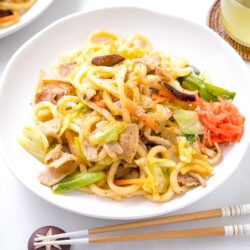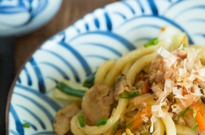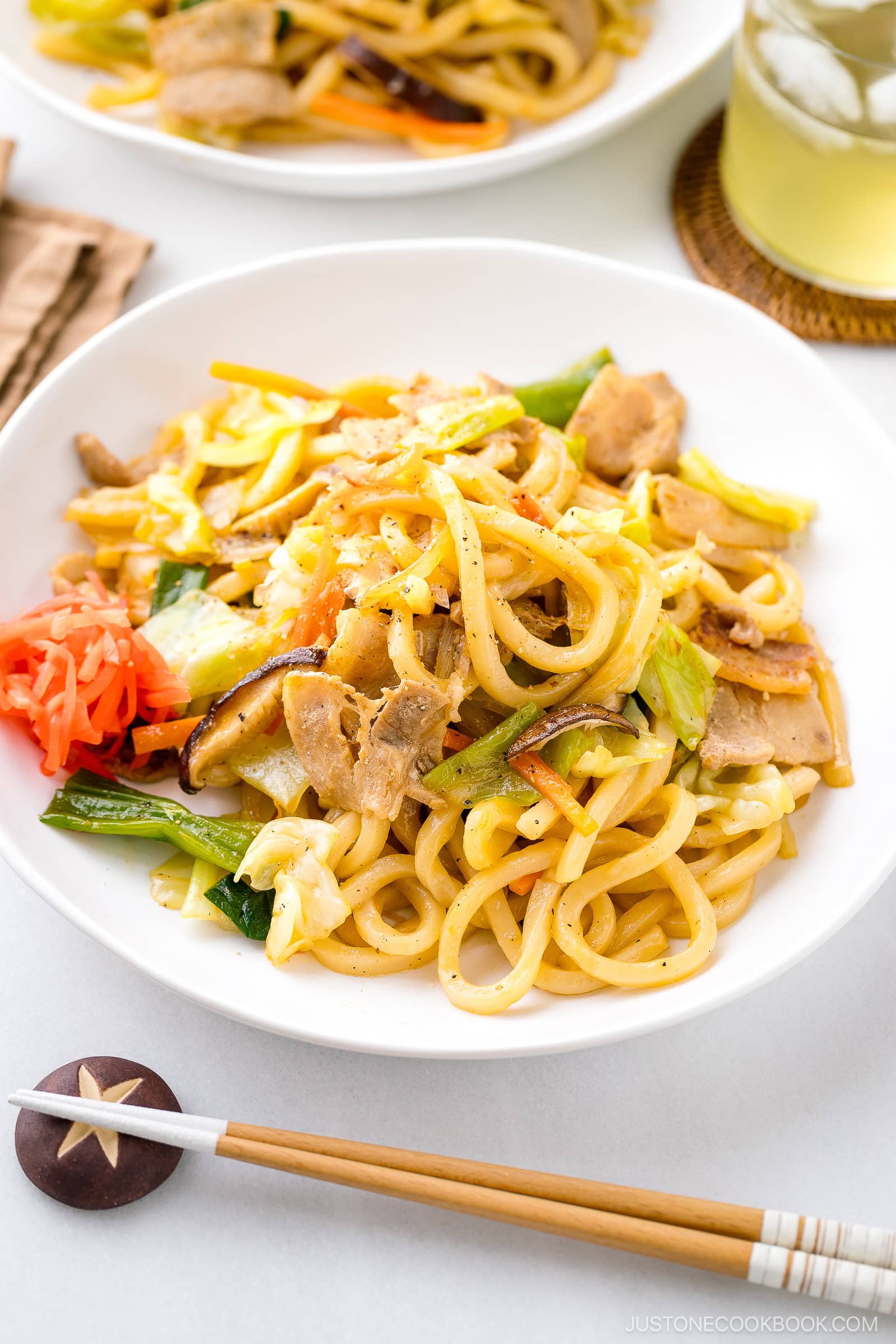
Is there anything more comforting than a hot plate of noodles? I always count on Yaki Udon (焼きうどん) as my go-to noodle dish any time of year. It’s fast, easy, and packed with umami flavors. What’s not to love? I’ll show you how to make authentic yaki udon at home.
If you’re craving more udon recipes, try my Beef Udon, Udon Noodle Soup, and Curry Udon next!
What is Yaki Udon?
Yaki udon (焼きうどん) is Japanese thick wheat noodles that are stir-fried with meat or seafood and vegetables and tossed in a sweet-savory sauce. It’s typically offered in three flavors in Japan—soy sauce, mentsuyu, or so-su (Japanese Worcestershire sauce). This dish is a variation on the wildly popular Yakisoba (焼きそば).
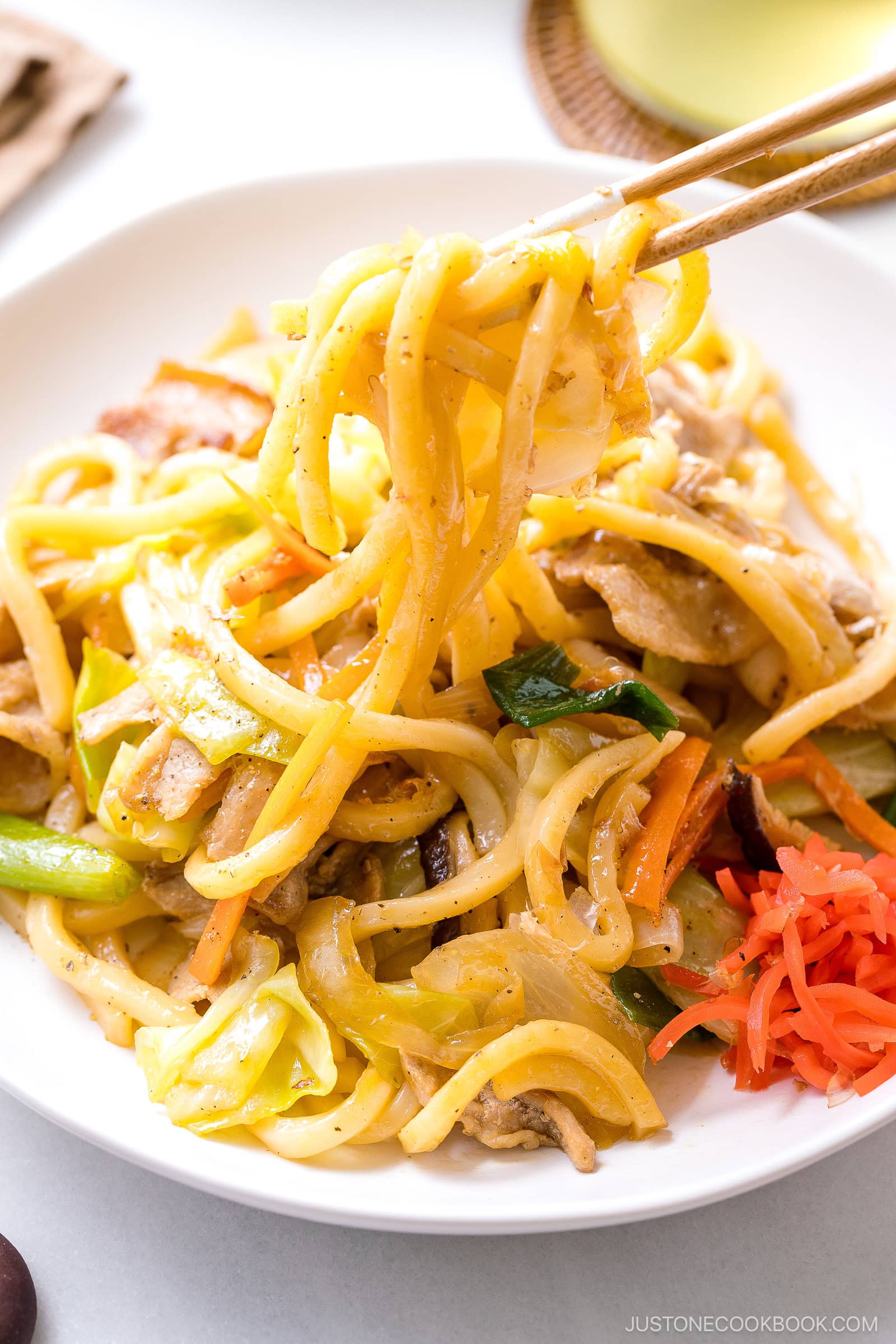
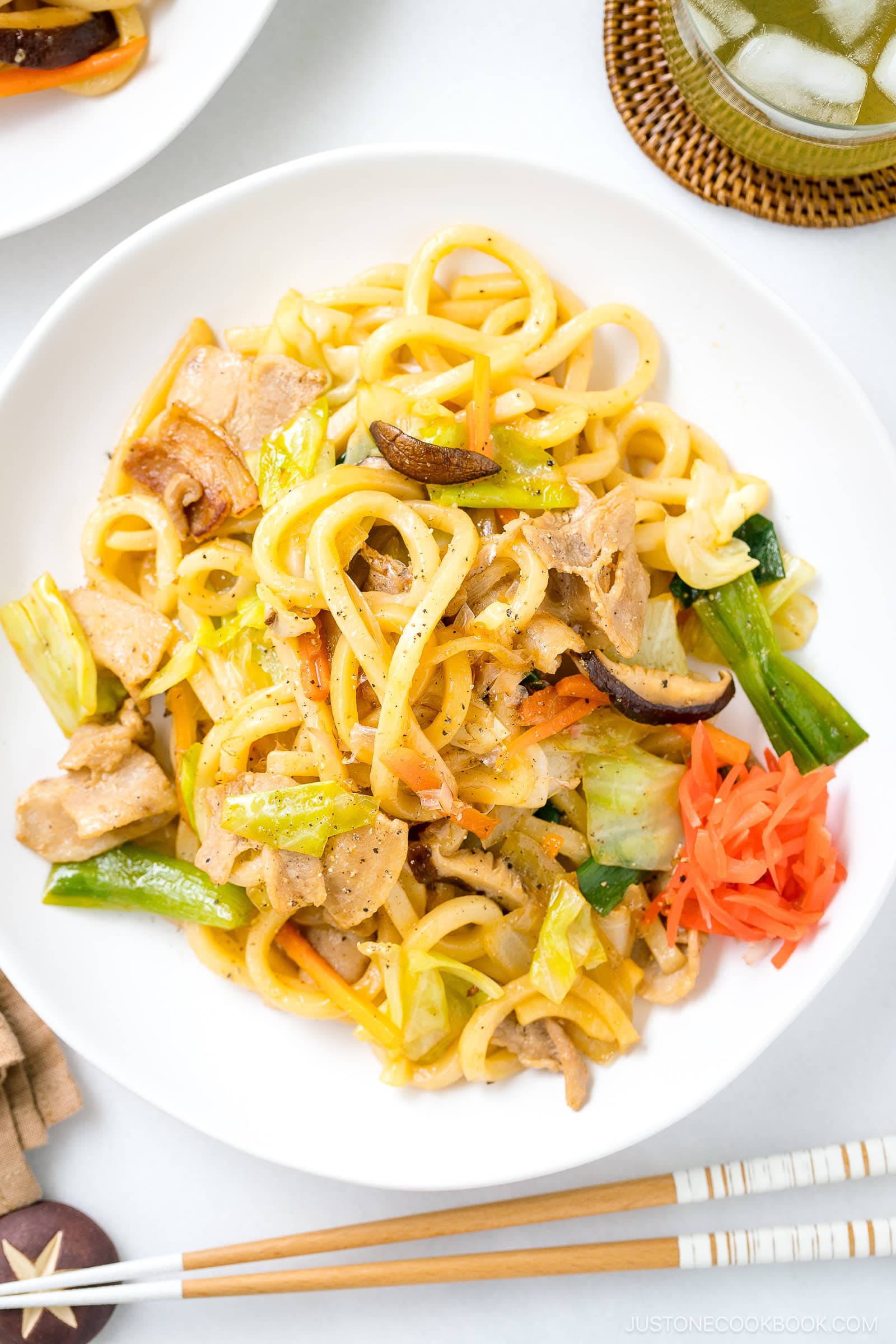
Ingredients for Yaki Udon
- Udon noodles – Fresh or frozen udon for the best texture.
- Sliced pork belly – This is the go-to protein for its rich flavor, available at Japanese or Asian grocery stores.
- Shiitake mushrooms
- Vegetables (green cabbage, carrot, onion, and green onions/scallions)
- Kosher salt and freshly ground black pepper
- Neutral oil
- Seasoning Option A
- Dashi powder – I use it as an umami booster and a salt substitute.
- Soy sauce, sake, and mirin (or pinch of sugar)
- Seasoning Option B (my go-to!)
- Mentsuyu – It’s a handy concentrated noodle soup base that I always keep at home for quick udon soup or sauces, but it’s not vegan friendly.
- Soy sauce
Find the printable recipe with measurements below.
Jump to RecipeSubstitutions
- Udon noodles: If you can’t find a Japanese or Korean brand, you can use dried udon noodles. While their texture is less chewy, at least they won’t break into pieces like refrigerated udon noodles. For gluten-free, try rice noodles.
- Sliced pork belly: You can use chicken, beef, or seafood such as shrimp and squid. For vegan/vegetarian options, you try thinly sliced fried tofu or tofu puffs instead.
- Dashi powder: For vegan/vegetarian, you can use kombu dashi powder or skip it altogether.
- Mentsuyu (or tsuyu): For a plant-based option, make my Homemade Mentsuyu, or you can use seasoning option A with kombu dashi powder.
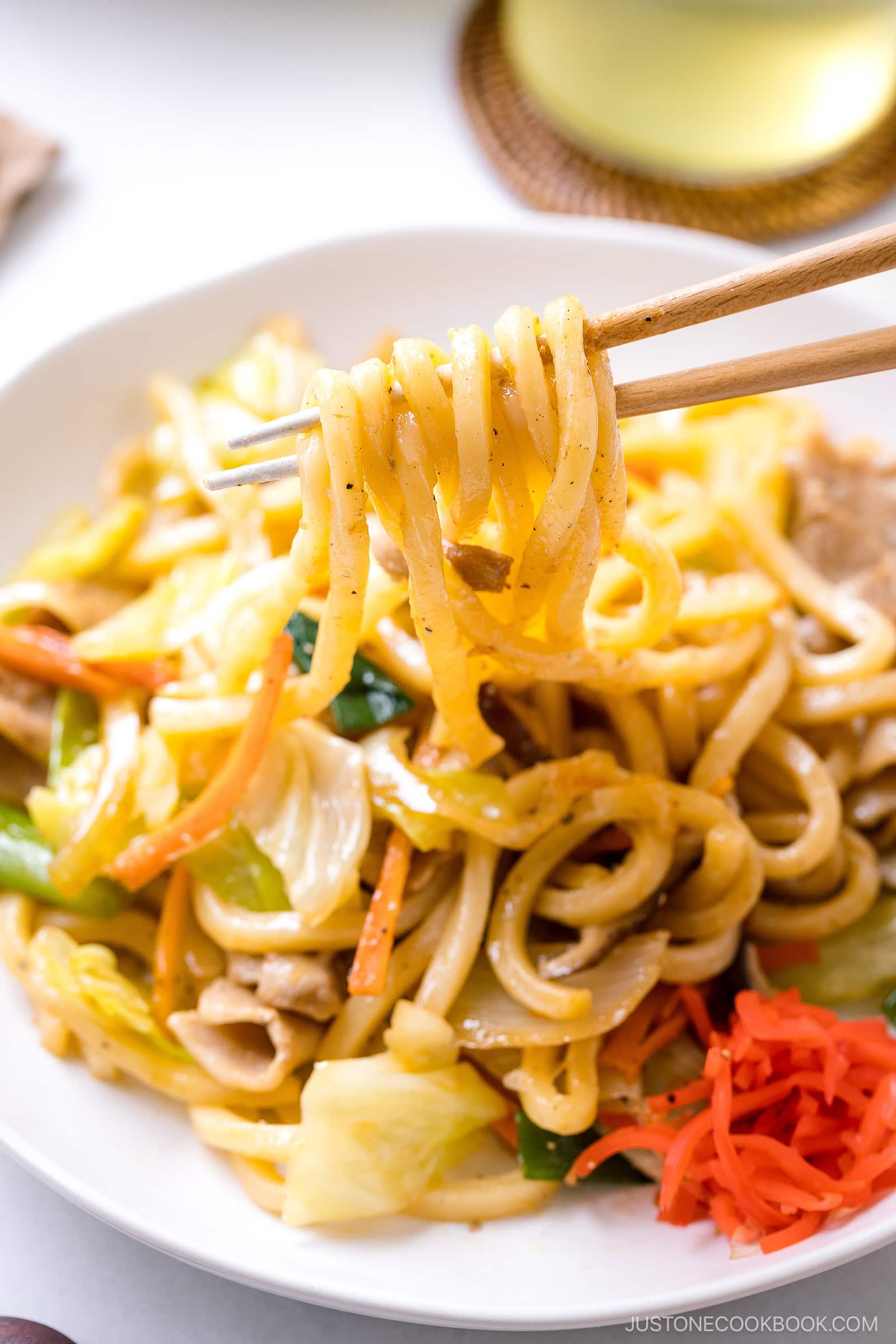
How to Make Yaki Udon
Preparation
Step 1 – Cut the ingredients. Slice the onion, carrot, and shiitake mushroom caps. Cut the green onion into 2-inch lengths. Cut the cabbage leaves and thin-sliced pork belly into 1-inch pieces.
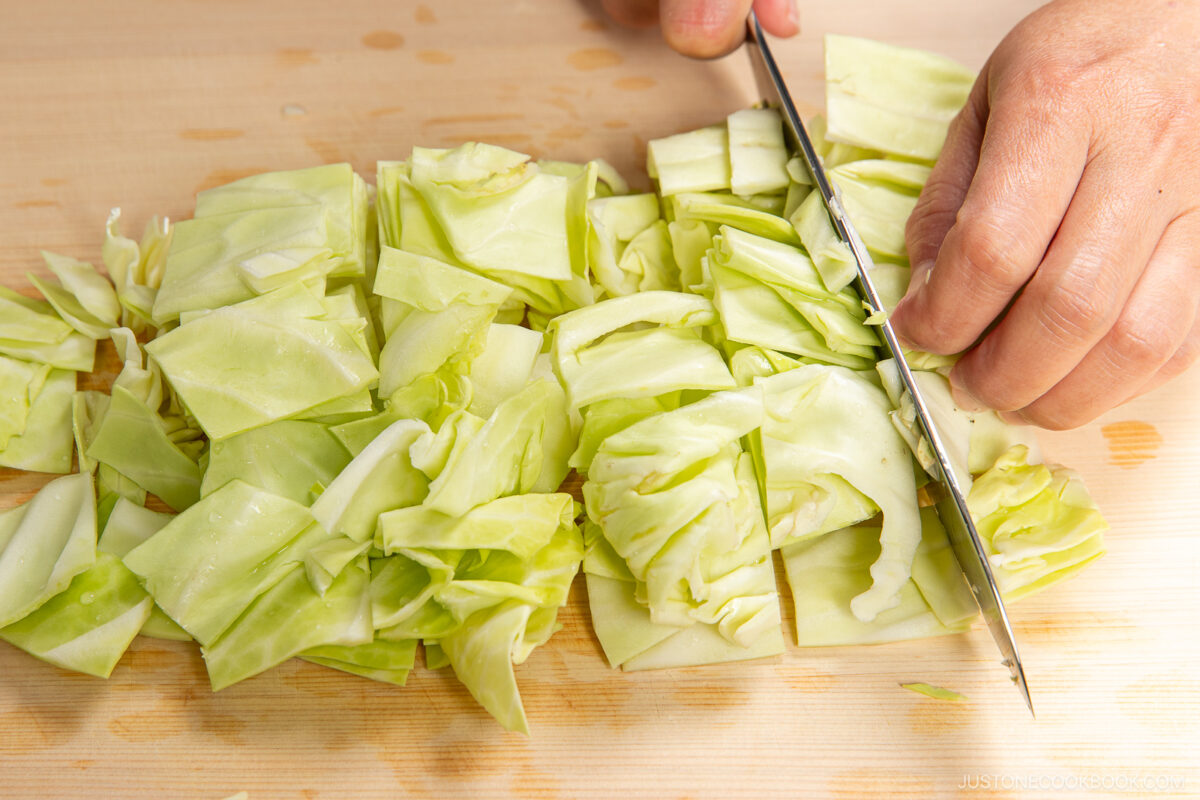
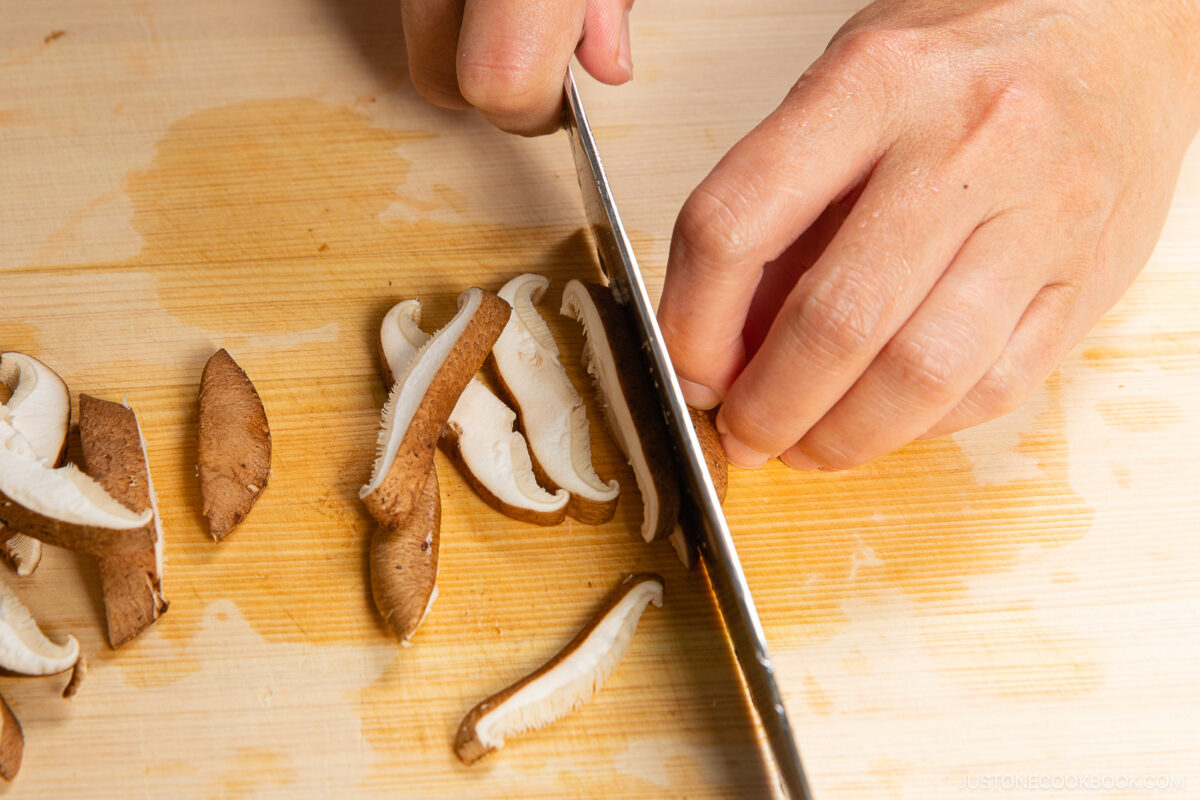
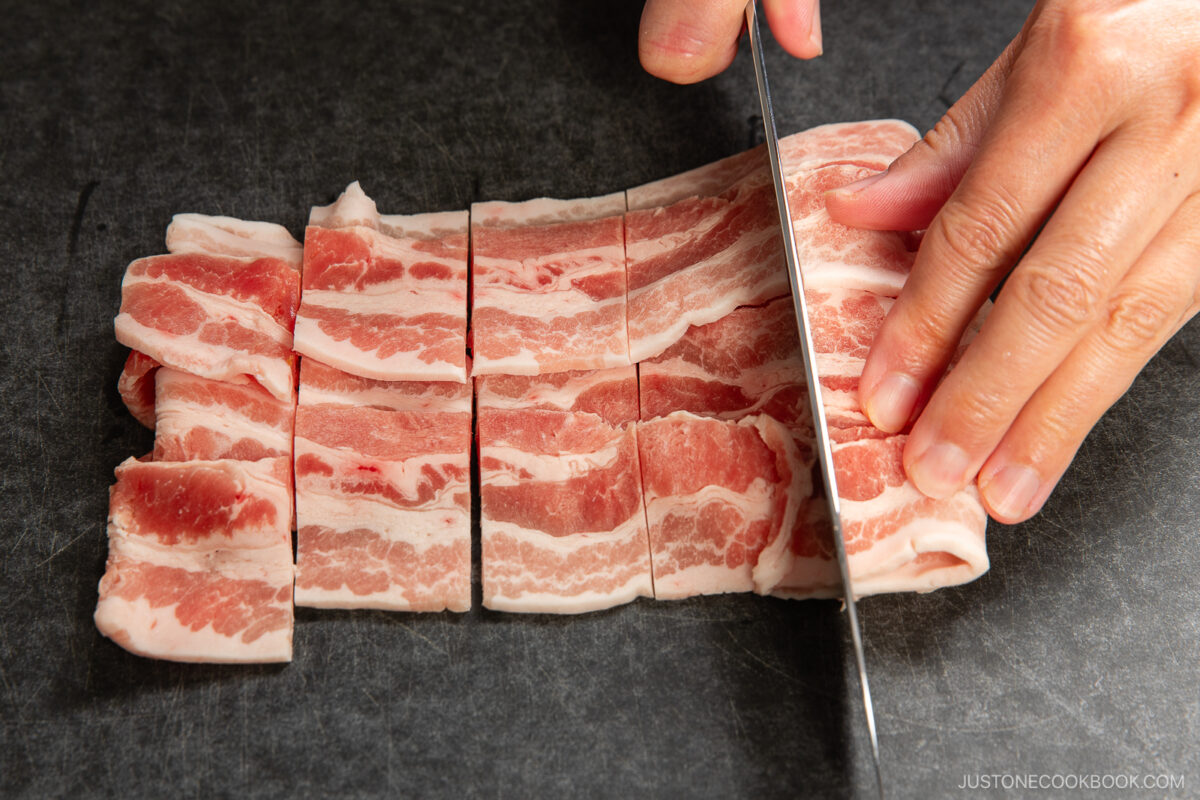
Step 2 – Blanch the udon noodles. It needs just 30–40 seconds in boiling water to loosen up frozen cooked udon. If you‘re using dry udon noodles, cook according to the package instructions. Transfer to a plate.
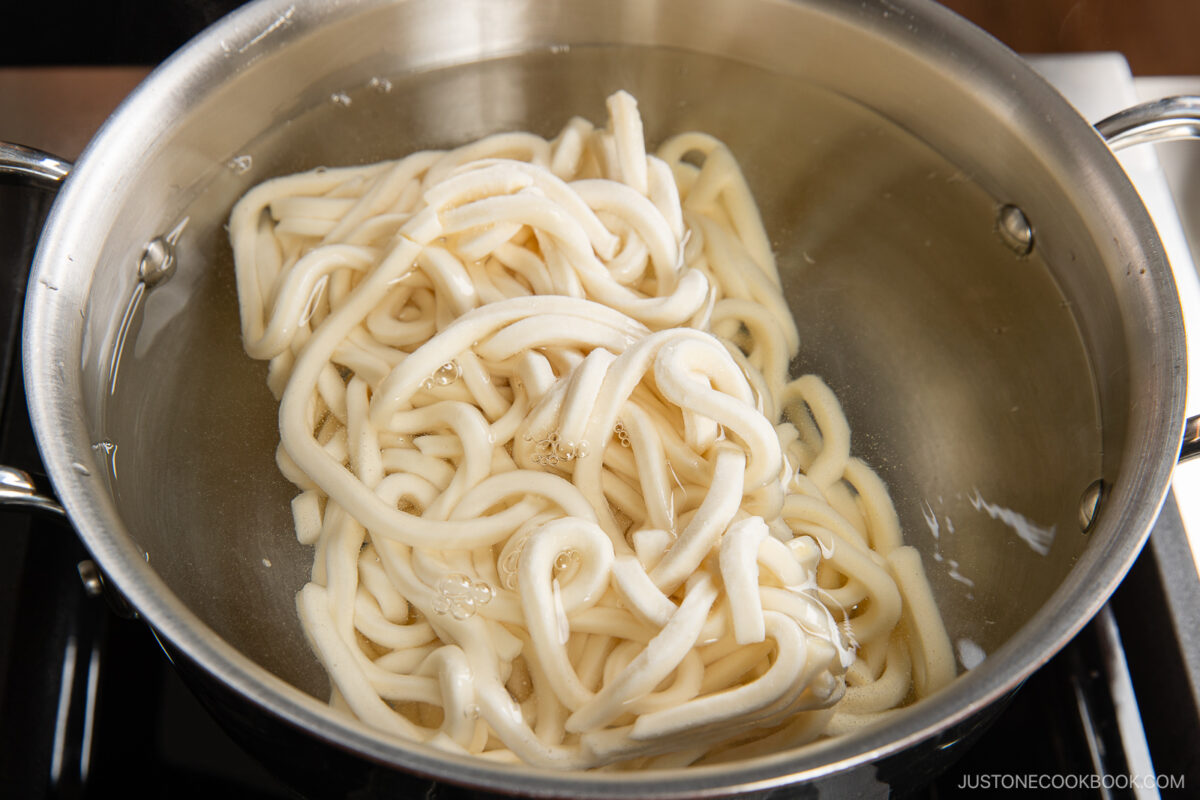
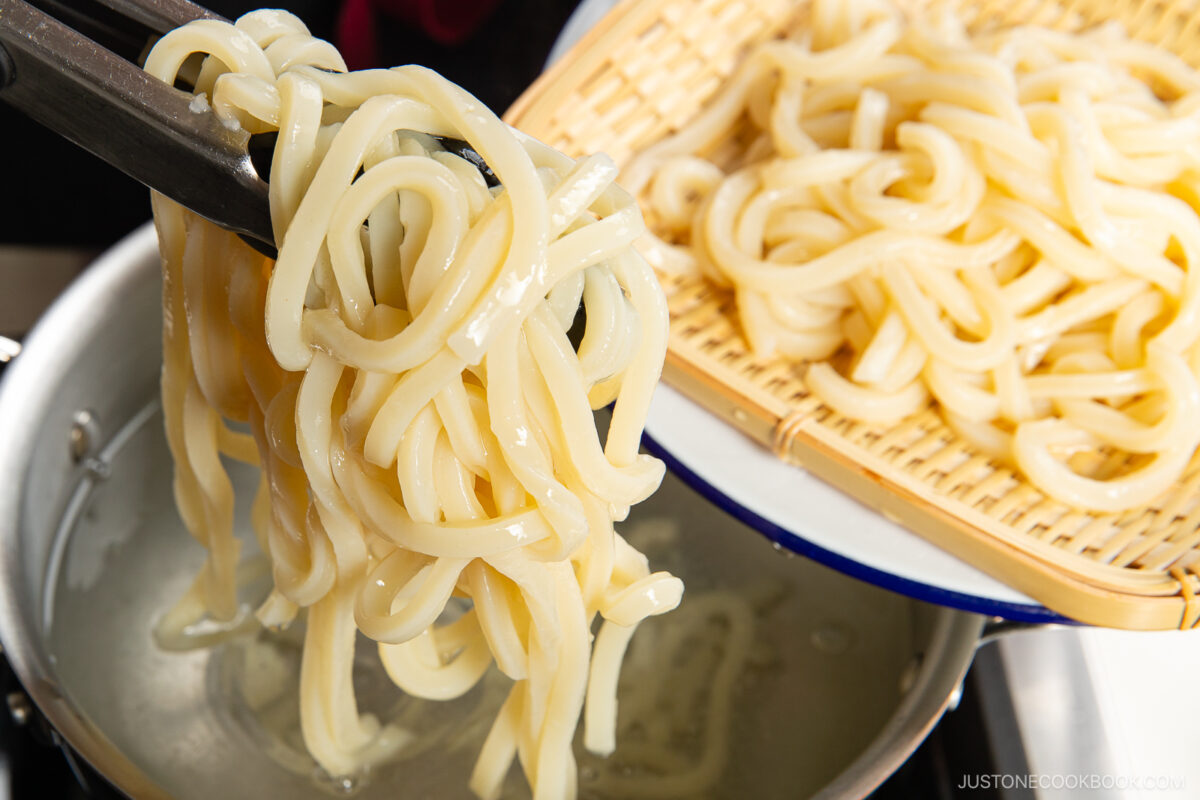
Cooking
Step 3 – Stir-fry and steam. Preheat a large skillet or frying pan and cook the pork belly until no longer pink. Add the vegetables, then cover to steam for 3 minutes.
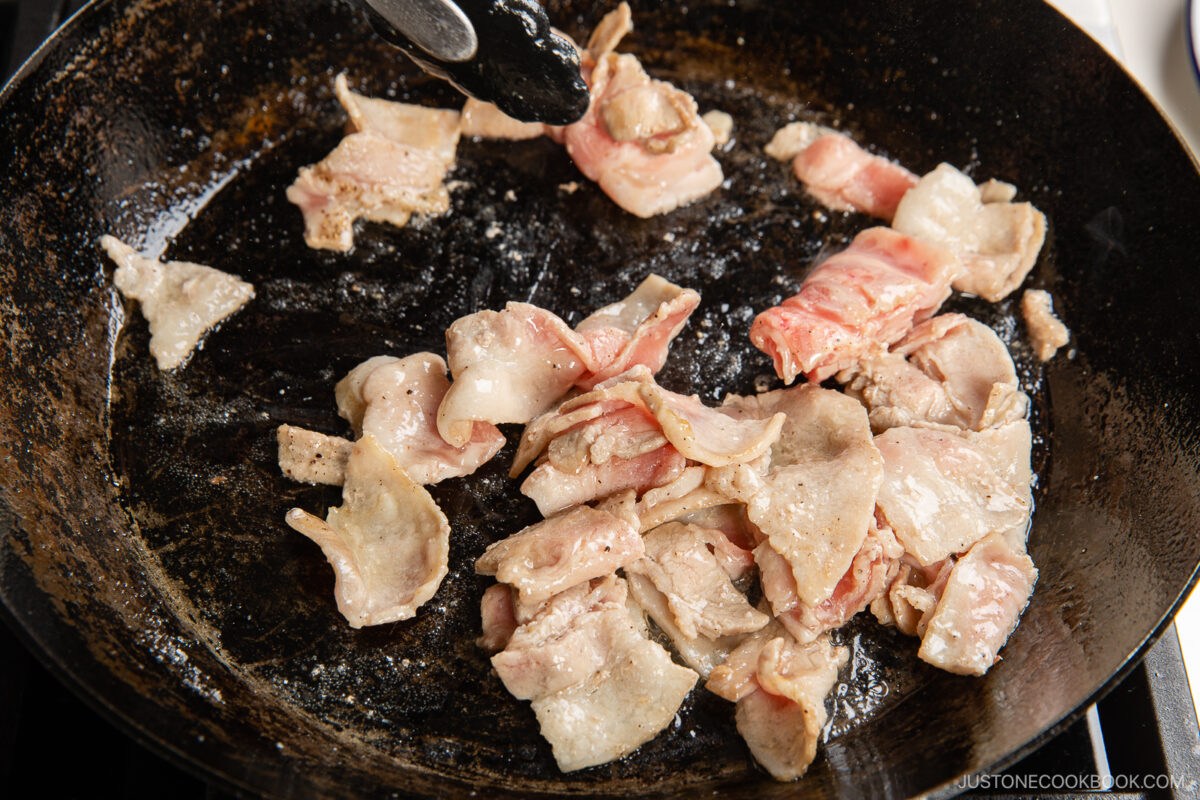
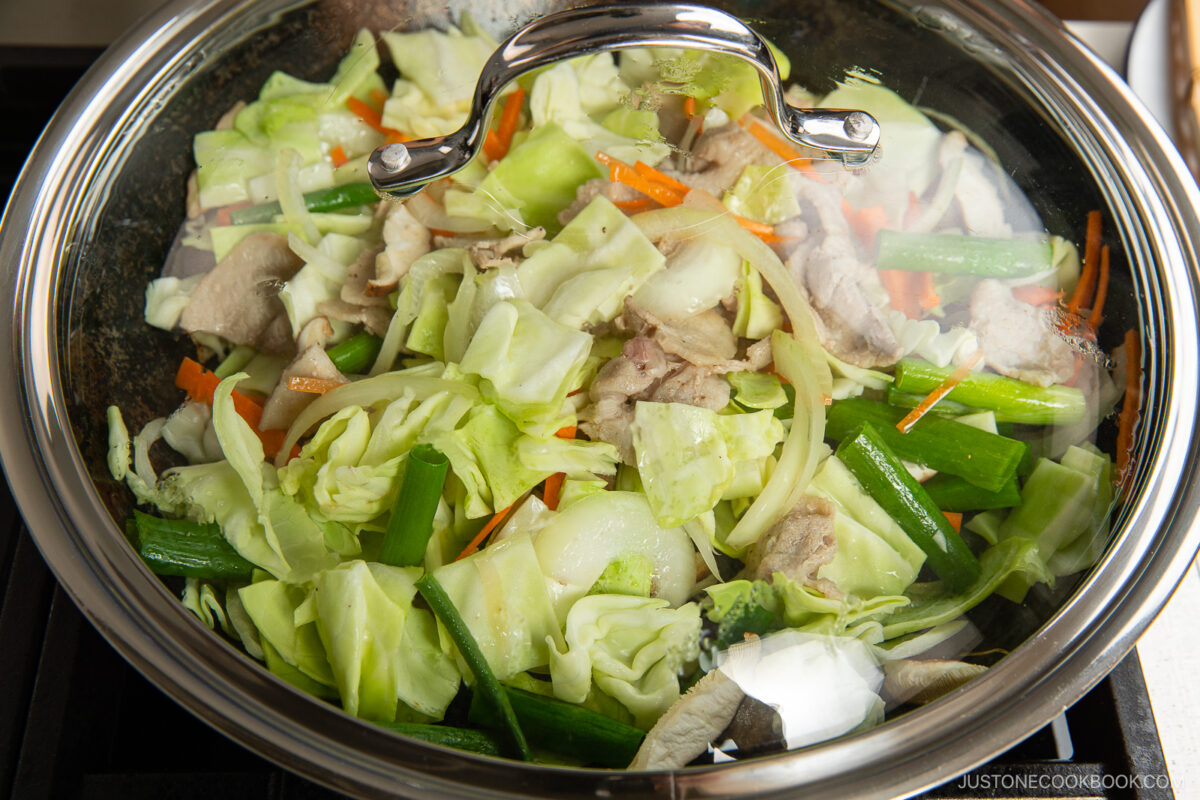
Step 4 – Toss in the noodles and season. Stir-fry the noodles and adjust the seasoning, adding more ground black pepper and salt if needed.
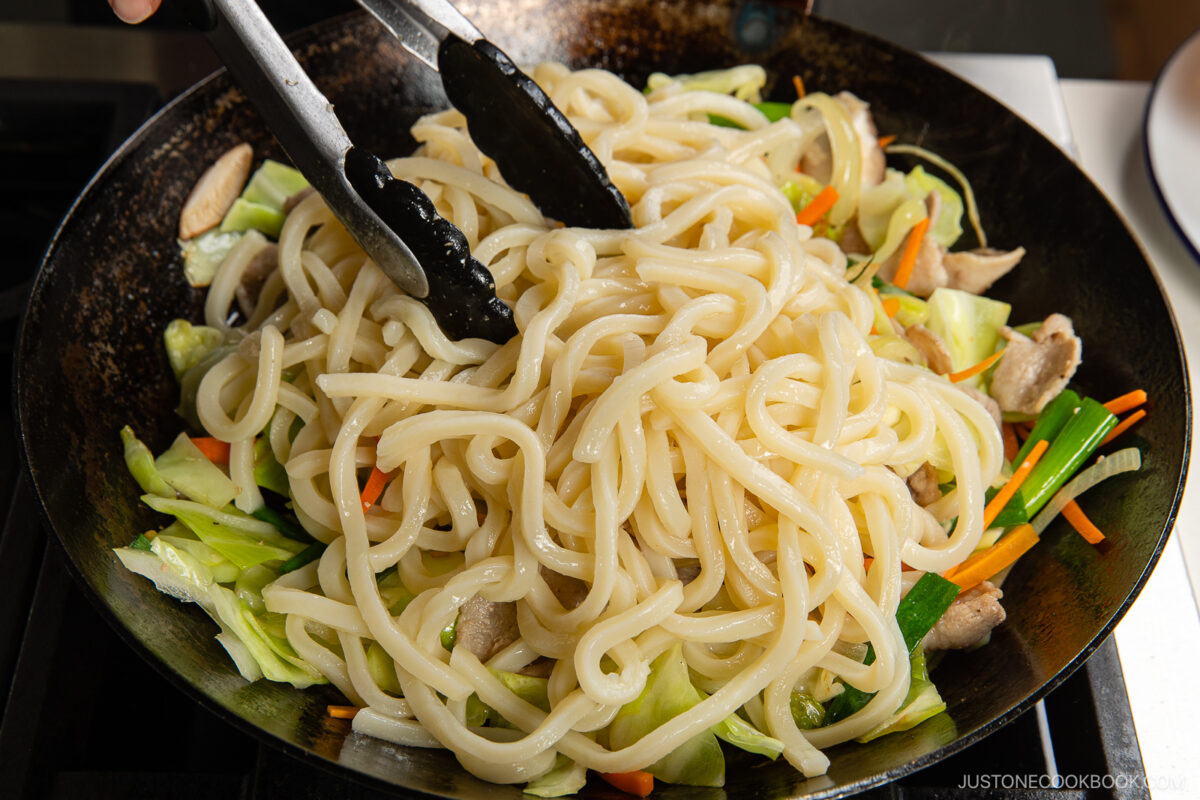
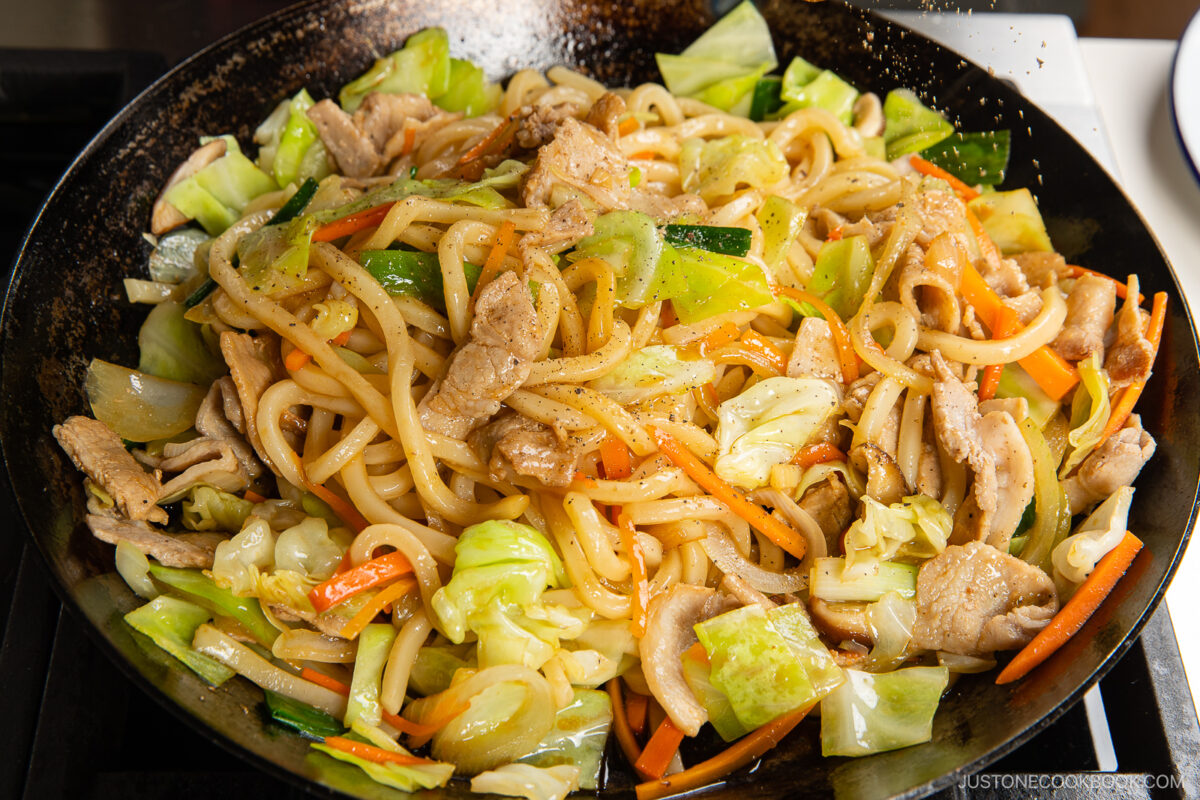
Assemble
Step 5 – Serve. Transfer to individual plates. Sprinkle optional bonito flakes and garnish with pickled red ginger.
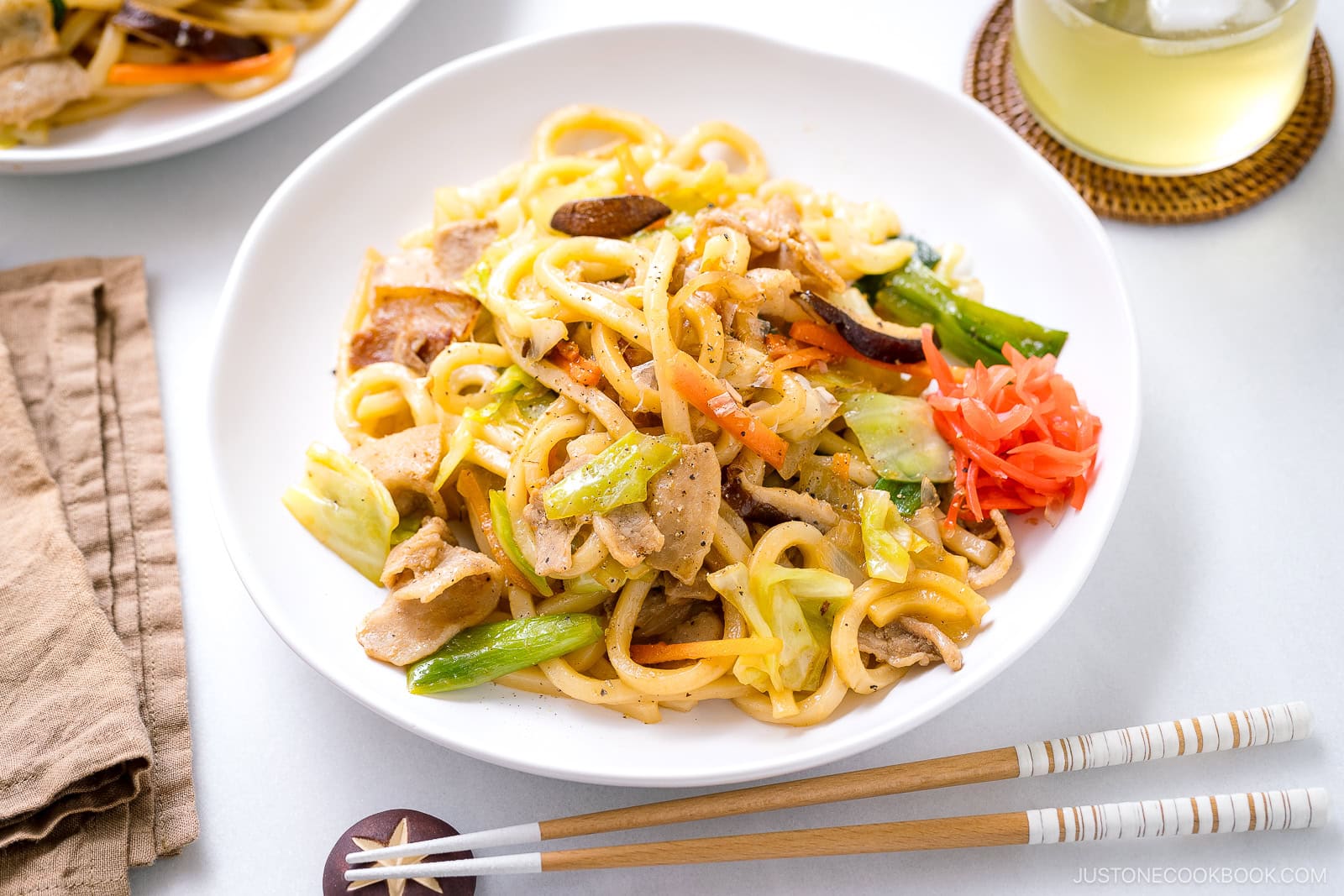
Nami’s Recipe Tips
- Don’t overcook the noodles – Frozen udon is already cooked—it just needs to be warmed and thawed. Once added to boiling water, set a timer for 1 minute or follow the package instructions.
- Use a large frying pan – I recommend using the biggest skillet or frying pan you have. Stir-frying requires more surface area, and it’s a big plus to have taller sides so the food stays in the pan. You could also use a large griddle or large wok that allows your ingredients to have direct contact with the hot surface.
- Cover and steam the veggies – Cover the frying pan to steam the veggies instead of stir-frying constantly. Do make sure to reduce the stove’s heat to low. With the moisture in the vegetables, all the bulky veggies will get steamed and become tender fast. If you don’t have a lid that fits your frying pan, you can continue to stir-fry the ingredients.
- Use a pair of tongs – It’s so much easier to mix the noodles and other ingredients with a pair of tongs rather than a pair of chopsticks or a spatula or two. Trust me on this!
- Season with mentsuyu for a delicious shortcut – If you have mentsuyu at home, definitely try my go-to seasonings option B because it‘s easy and delicious!
- Always stock udon noodles – As a general tip, I recommend always keeping frozen or dried udon noodle packages at home. This way, you can make delicious yet simple udon dishes instead of getting takeout or eating out. My daughter loves udon noodles so I always keep some in my freezer for a quick meal.
Variations and Customizations
Yaki udon is a versatile dish that you can switch up with your preferences or what you have on hand. Here are my suggestions for customizing it.
- Choose your protein. Swap out the pork with your favorite protein. I recommend chicken pieces, thinly sliced beef, peeled and deveined shrimp, mixed seafood, or sliced fried tofu. Please adjust the cooking time accordingly.
- Experiment with different vegetables. I use classic cabbage, carrot, onion, and shiitake, but you can try thin strips of bell pepper, broccoli, or bok choy. For the best texture, I recommend using veggies that stay crisp when stir-fried.
- Short on time? Anyone can whip up my 10 Minute Meal – Yaki Udon in a dorm or small apartment, even on the busiest days. Plus, it cooks in one pot for easy clean up!
- Make it plant-based. Leave out the meat and make vegetable yaki udon! Add thinly sliced fried tofu (or tofu puffs) and an extra 1 cup of vegetables. I suggest thinly sliced or chopped bell peppers, broccoli, and different mushrooms.
What to Serve with Yaki Udon
This stir-fried udon is a delicious and satisfying meal in itself. To compose a meal, add some simple side dishes. Here are a few of my suggestions.
- With an appetizer – Learn How to Cook Edamame as a healthy starter.
- With a vegetable side – Lighten things up with refreshing Japanese cucumber salad or Japanese Spinach Salad with Sesame Dressing (Gomaae).
- With a protein side – Try adding a savory protein boost like Agedashi Tofu or gyoza (Japanese potstickers).
- With soup – For the ultimate comforting touch, serve a bowl of Homemade Miso Soup.
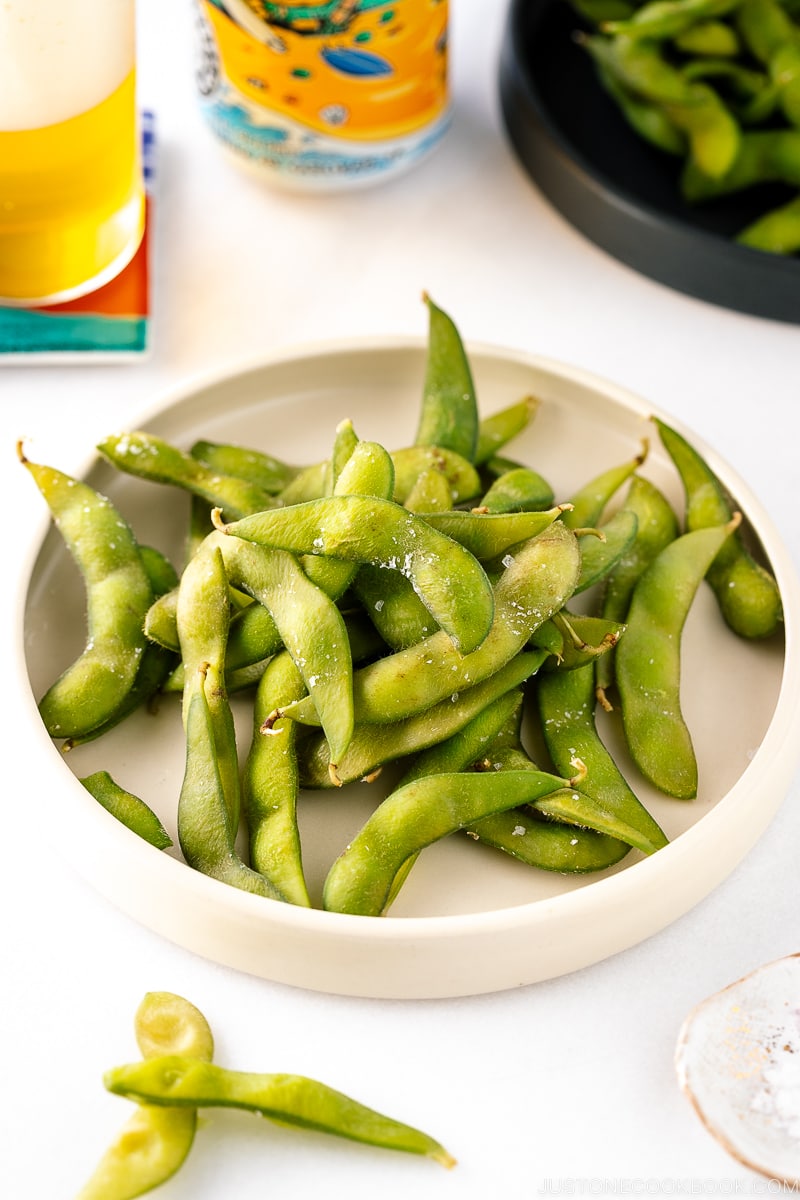
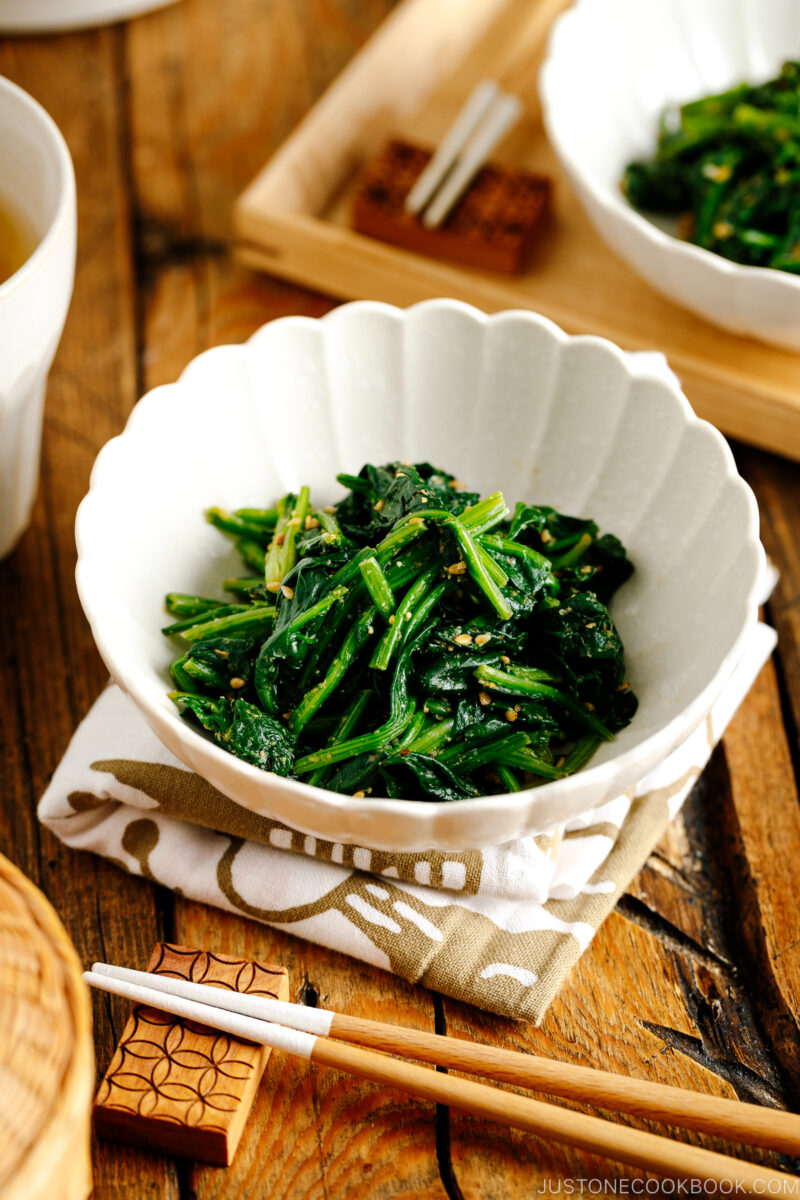
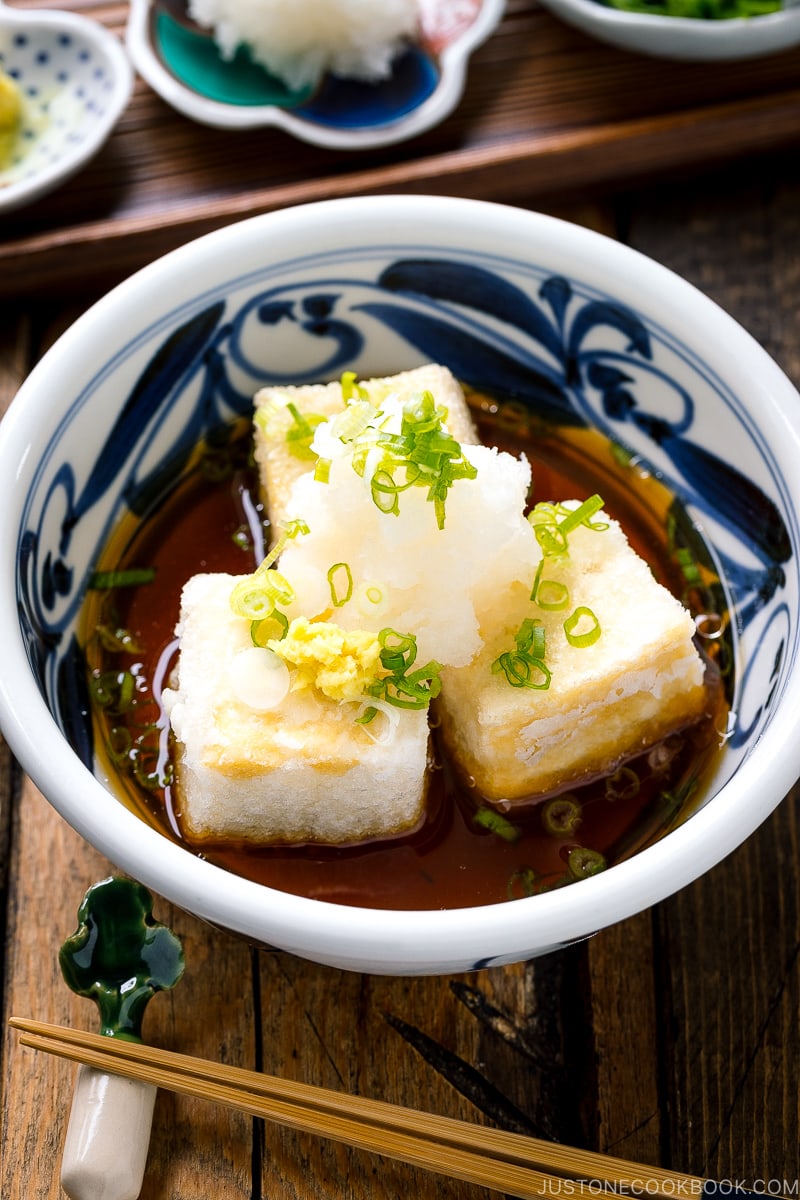
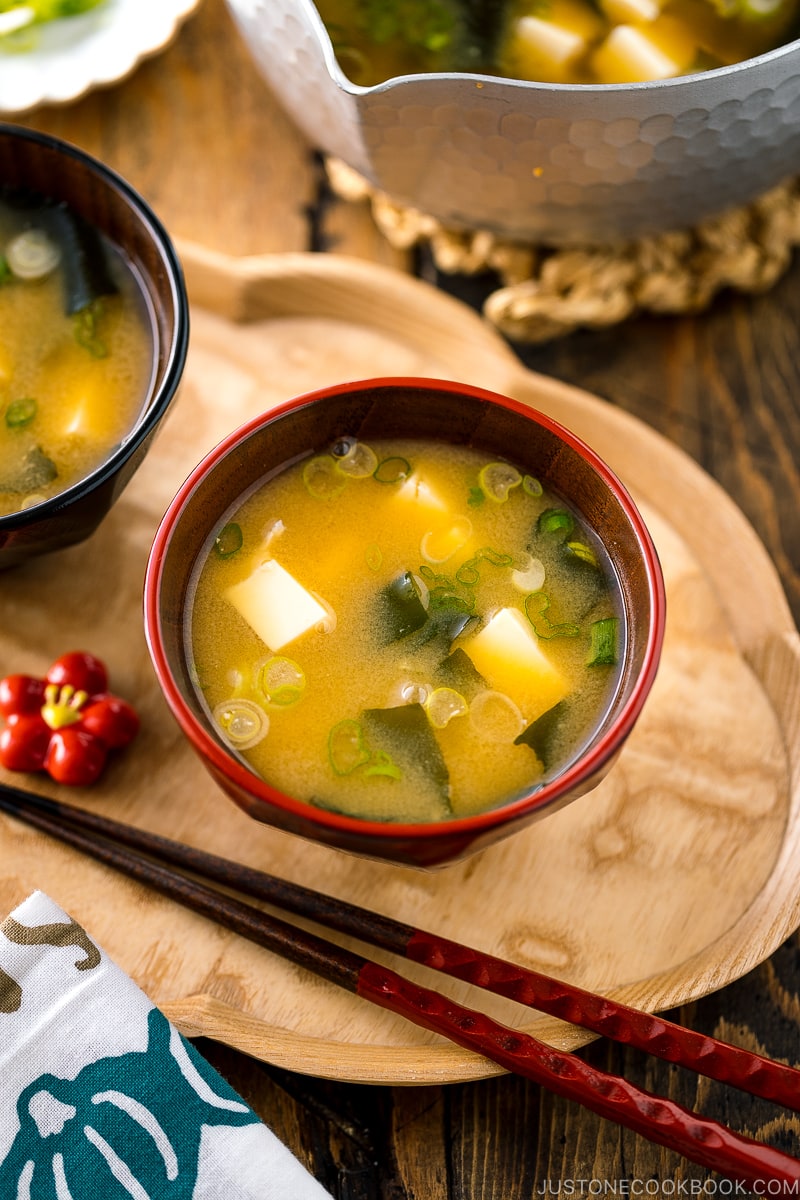
Storage Tips
To store: You can keep the leftovers in an airtight container and store in the refrigerator for up to 3–4 days and in the freezer for a month.
Frequently Asked Questions
Udon noodles are made from wheat flour, so they are not gluten-free and unsuitable for people with celiac disease or gluten intolerance. Please use rice noodles instead!
For an authentic flavor, I do not recommend using oyster sauce for yaki udon, as its intensity can overpower the dish. The sauce I’m sharing here is flavorful on its own while preserving the delicate taste of Japanese food that we appreciate.
Some online recipes also call for sesame oil, dark soy sauce, and garlic. Please note that we don’t use these ingredients or oyster sauce in authentic yaki udon. Yaki udon in Japan is light in color and not dark-colored noodles. That would be more of a Chinese-style noodle dish.
If it is your only option, you could use instant udon noodles from mainstream grocery stores. However, keep in mind they are more doughy in taste and tend to break easily.
Yaki Udon (Japanese Stir-Fried Udon Noodles)
Ingredients
- ½ onion (3.5 oz, 100 g)
- 2–3 leaves green cabbage (8 oz, 227 g)
- 2 inches carrot (1.8 oz, 50 g)
- 2 shiitake mushrooms (0.7 oz, 20 g)
- 2 green onions/scallions
- 6 oz sliced pork belly (or your choice of meat or seafood; substitute tofu, mushrooms, or extra vegetables for vegetarian/vegan)
- 2 servings udon noodles (1.1 lb/500 g frozen or parboiled udon noodles; 6.3 oz/180 g dry udon noodles)
- 1 Tbsp neutral oil (for cooking)
- ⅛ tsp Diamond Crystal kosher salt (plus more to taste)
- ⅛ tsp freshly ground black pepper (plus more to taste)
For the Seasonings: Option A
- ½ tsp dashi powder (use kombu dashi powder for vegetarian/vegan or skip)
- 2 Tbsp soy sauce
- 1 Tbsp sake
- 1 tsp mirin (or a pinch of sugar)
For the Seasonings: Option B
- 3 Tbsp mentsuyu (concentrated noodle soup base) (for mentsuyu that is 3-times concentrated; if you use non-concentrated mentsuyu, please add more to achieve the same flavor; you can make my Homemade Mentsuyu)
- 1 tsp soy sauce
For the Garnish (optional)
- 3 Tbsp katsuobushi (dried bonito flakes) (or 1–2 small packages of katsuobushi; skip for vegetarian/vegan)
- 2 Tbsp pickled red ginger (beni shoga or kizami beni shoga)
Instructions
- Gather all the ingredients. I used seasonings option A in this recipe demonstration. Now, bring a large pot of water to a boil on medium-high heat for boiling the udon noodles later. In the meantime, prepare the rest of the ingredients.
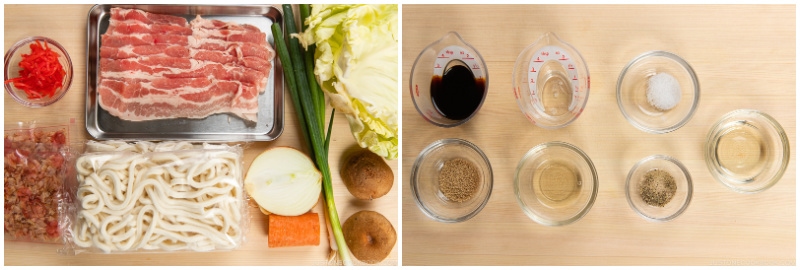
To Prepare the Ingredients
- Slice ½ onion thinly.
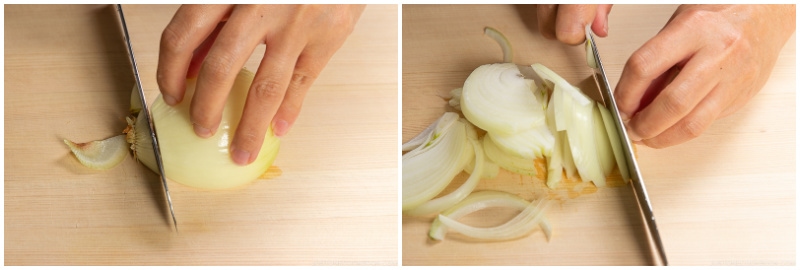
- Remove the tough core of 2–3 leaves green cabbage. Then, cut the leaves into pieces that are 1 inch (2.5 cm) square.
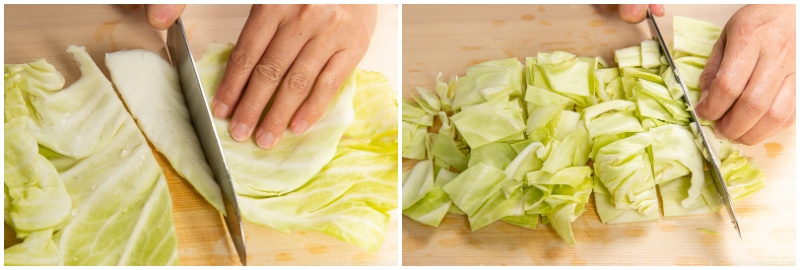
- Peel 2 inches carrot and cut it into thin slabs. Then, julienne the slabs into thin strips 2 inches (5 cm) long.
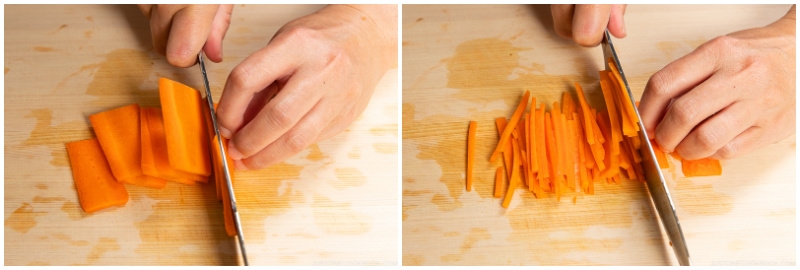
- Discard the tough stems of 2 shiitake mushrooms and slice the mushroom caps.
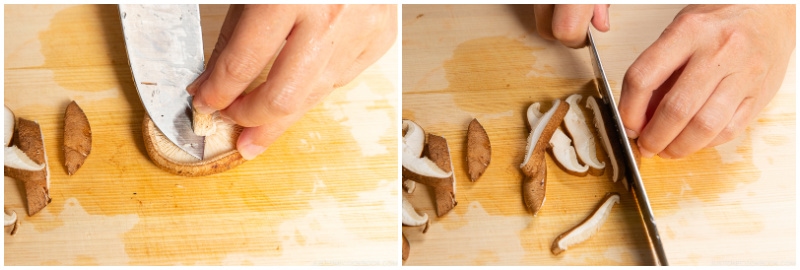
- Cut 2 green onions/scallions into 2-inch (5 cm) pieces. Cut 6 oz sliced pork belly slices into 1-inch (2.5 cm) pieces.
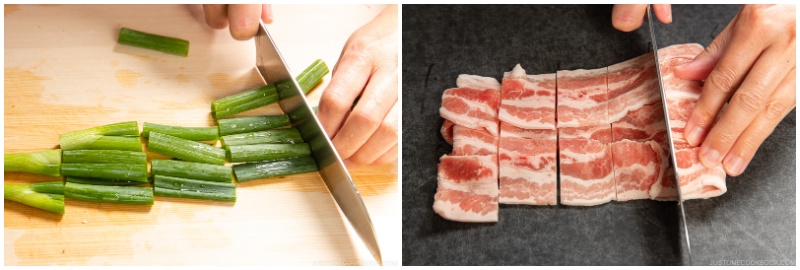
- When the water is boiling, blanch 2 servings udon noodles (frozen) for 30–40 seconds or until it just starts to loosen up. If you‘re using dry udon noodles, boil them according to the package instructions. Transfer the noodles to a plate and set aside.
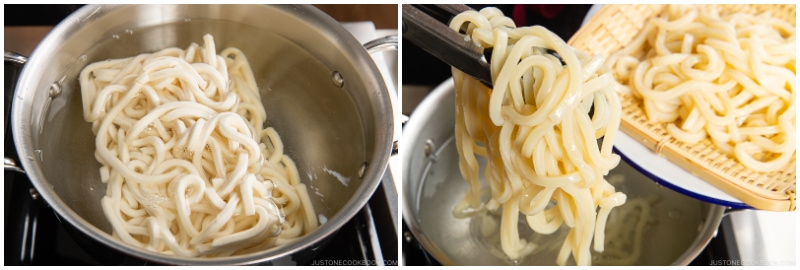
To Stir-Fry the Yaki Udon
- Preheat a large frying pan over medium heat. When the pan is hot, add 1 Tbsp neutral oil and distribute it evenly. Add the pork belly and stir-fry.
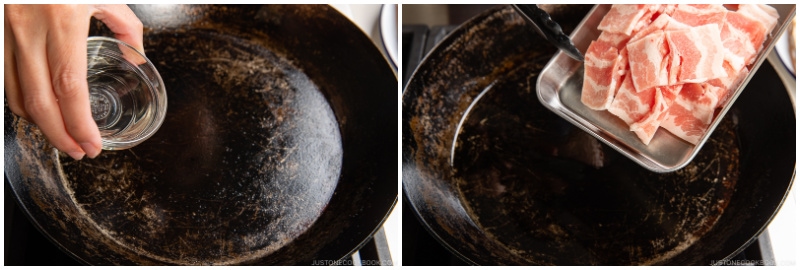
- Season the pork with ⅛ tsp Diamond Crystal kosher salt and ⅛ tsp freshly ground black pepper. Cook until it‘s no longer pink.
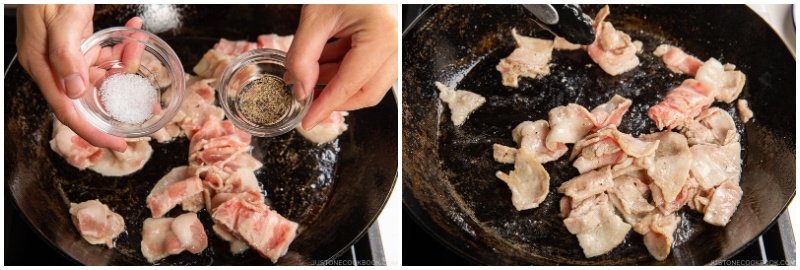
- Add the onion slices and stir-fry until tender.
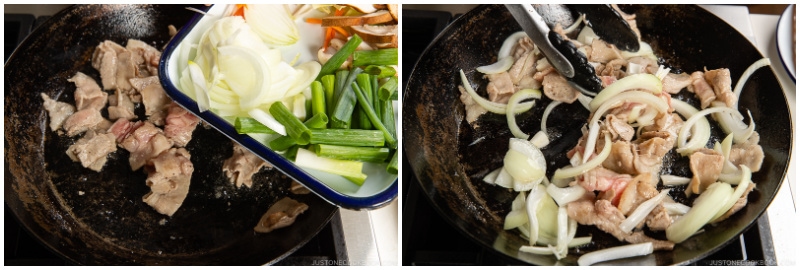
- Add the cabbage, carrot strips, shiitake mushrooms, and green onions. Mix it all together until the ingredients are coated with oil.
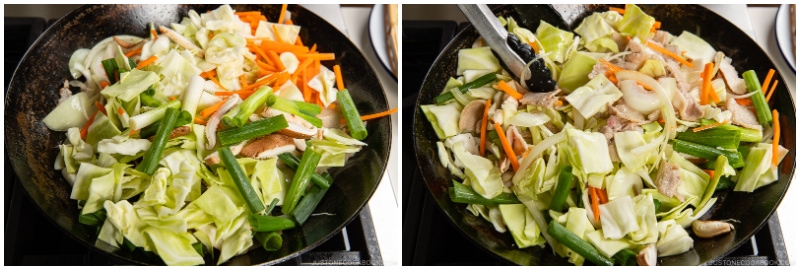
- Cover with a lid and reduce the stove‘s heat to low. Let the ingredients steam for 3 minutes, or until the vegetables are slightly wilted.
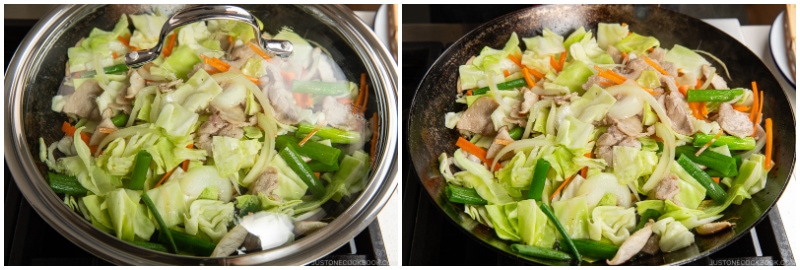
- Add the udon noodles to the pan and toss with a pair of tongs to combine. (It‘s a lot easier to use tongs than two spatulas).
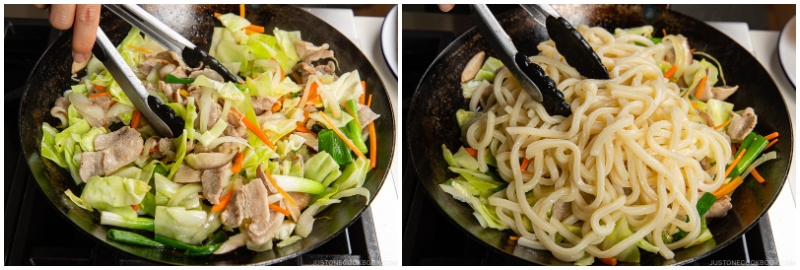
- Add the ingredients for either seasonings option A or B to the pan. For option A, add ½ tsp dashi powder, 2 Tbsp soy sauce, 1 Tbsp sake, and 1 tsp mirin. If you‘re using option B, add 3 Tbsp mentsuyu (concentrated noodle soup base) and 1 tsp soy sauce. Tip: If you have mentsuyu at home, definitely try my go-to seasonings option B because it‘s easy and delicious!
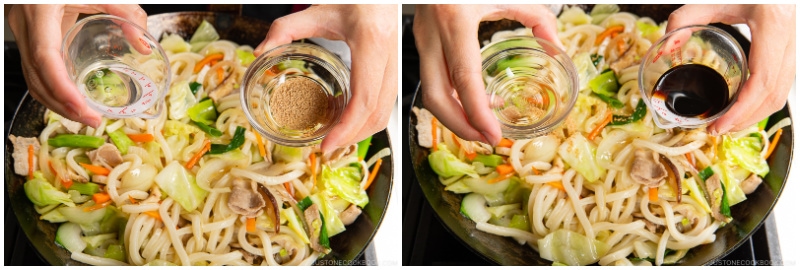
- Mix it all together. Taste and adjust the seasoning, adding more ground black pepper and salt to your liking.
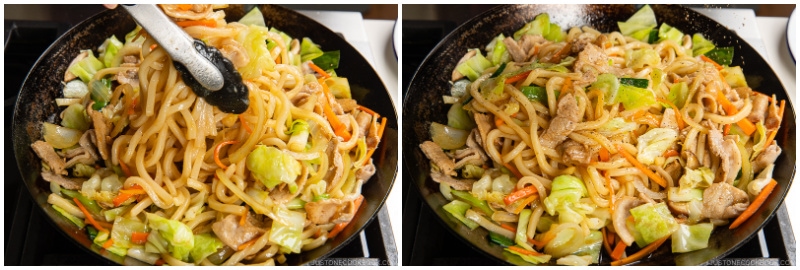
To Serve
- Transfer the Yaki Udon to individual plates. Optionally, divide 3 Tbsp katsuobushi (dried bonito flakes) and sprinkle on top and divide 2 Tbsp pickled red ginger (beni shoga or kizami beni shoga) and garnish on the side of each plate.
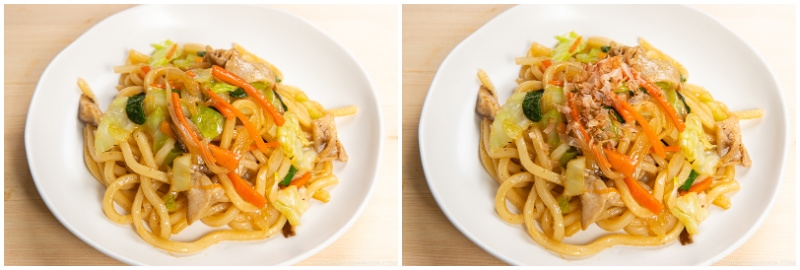
To Store
- You can keep the leftovers in an airtight container and store in the refrigerator for up to 3–4 days and in the freezer for a month.
Nutrition
Did you make this recipe?
Tag @justonecookbook on Instagram so we can see your delicious creation!
Editor’s Note: This post was originally published in January 2011. It was republished with a new video, revised recipe, and updated content on May 2, 2022.



